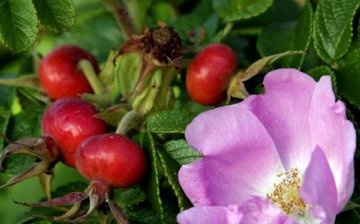Rosehip in the photo and its cultivation in the garden
I think that everyone knows this thorny bush since childhood. In spring and summer, the dog rose blooms with delicate and fragrant flowers, and in autumn its bushes are strewn with bright orange-red berries.
Looking at the dog rose in the photo, one can already assume the size of this shrub: it grows from one meter to three in height, and is prone to branching.
It is known that rose hips contain a very large amount of vitamin C. Knowing the secrets of growing this plant, you can always have this natural healer on your site.
Rosehips in the photo in garden plots are often captured planted in higher elevations. For this shrub, a planting site slightly elevated above the ground surface is optimal. It is also necessary to provide the rose hips with good lighting.
Certain soil recommendations will also have to be followed: they plant rose hips in fertile areas with good drainage. In the lowlands, where waterlogging and even waterlogging of the soil is possible, it is not worth planting a rosehip, a strong plant cannot be grown under such conditions.
Rosehip care is simple: the plant requires loosening of the soil, regular watering, cutting off dead or weak branches.
It is recommended to form each rose hip bush from about 15-20 shoots, leaving branches of different ages. From about the age of 7-10 years, the fruiting of the branches decreases, therefore it will be necessary to radically rejuvenate the rosehip bushes.
Rosehips are mainly affected by three types of pests: spider mites, leaf rollers and aphids. Therefore, just in case, you need to stock up on drugs from these groups of pests.




Rosehip is definitely a plant with very healthy fruits. I add it with pleasure to compote in winter, sometimes I even make decoctions. But I prefer to buy them, the roots of the rose hips create big problems if it is necessary to transplant the bushes.